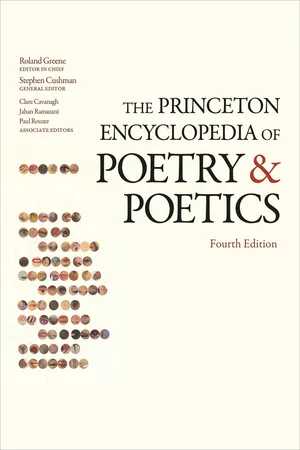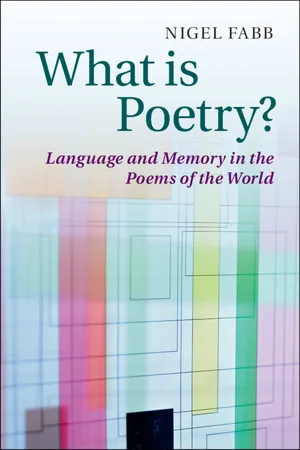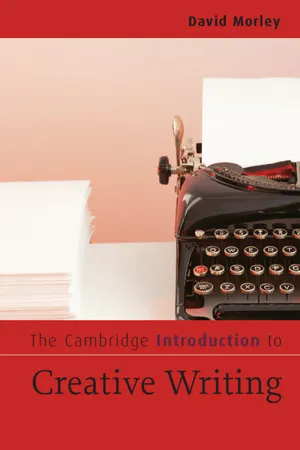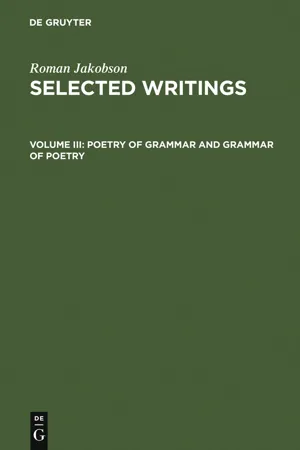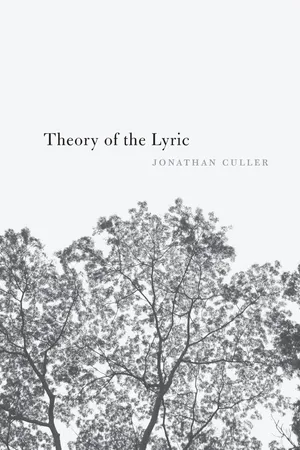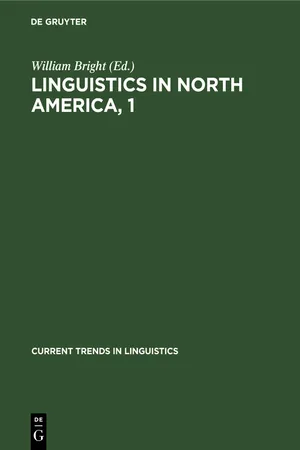Languages & Linguistics
Rhymes
Rhymes are words that have similar sounds at the end, often used in poetry and song lyrics to create rhythm and musicality. They can be categorized based on the type of sound repetition, such as perfect rhymes (e.g., cat and hat) or slant rhymes (e.g., prove and love). Rhymes are an important aspect of phonetics and phonology in language study.
Written by Perlego with AI-assistance
8 Key excerpts on "Rhymes"
- eBook - ePub
The Princeton Encyclopedia of Poetry and Poetics
Fourth Edition
- Stephen Cushman, Clare Cavanagh, Jahan Ramazani, Paul Rouzer, Stephen Cushman, Clare Cavanagh, Jahan Ramazani, Paul Rouzer(Authors)
- 2012(Publication Date)
- Princeton University Press(Publisher)
Rhyme is widely used not only for ludic and didactic purposes, as in rhymed and rhythmical calendrical mnemonics, children’s counting-out and jump-rope Rhymes, and jingles for ads (see Chasar) but for other types of memorable speech such as *proverbs, *epigrams, inscriptions, mottoes, *riddles, puns, and jokes (Brogan). Children seem to be able to manufacture Rhymes not only spontaneously and happily but more readily than the other six forms cited at the top of section II.B above, suggesting that the closural or “final-fixed” structure that is rhyme is somehow more salient for cognitive processing (see Rayman and Zaidel), as the vast lit. on the role of rhyme in promoting children’s phonemic awareness, lang. acquisition, and literacy suggests. Perhaps the most common form of rhyming in lang. is seen in mnemonic formulas, catch phrases that rhyme, e.g., true blue, ill will, fender bender, double trouble, high and dry. The list of such popular and proverbial phrases is astonishingly long, and the device is also used in poetry (Donne, “Song (Go and Catch a Falling Star”); Eliot, Four Quartets ; see CLOSE RHYME). In an important study, Bolinger has shown that in every lang., words that begin or end alike in sound come to be perceived as related even when they have no etymological connection. This sort of paradigmatic or synchronic associativity is even stronger than the historical kinship of words, which is often concealed by spelling and pronunciation changes, and is extended naturally into poetry as rhyme without any alteration of form or function. The inevitability of rhyme suggested by this study becomes harder to deny in light of evidence that rhyme-like structures apparently exist even in nonhuman langs., such as that of whales (Guinee and Payne), challenging those who think of rhyme as more artificial than natural to reconsider. J. S. Schütze, Versuch einer Theorie des Reims nach Inhalt und Form (1802)—Kantian semantic theory; T - eBook - PDF
What is Poetry?
Language and Memory in the Poems of the World
- Nigel Fabb(Author)
- 2015(Publication Date)
- Cambridge University Press(Publisher)
I have not found research that shows whether the sections ending in Rhymes are sufficiently short that they can each be held as a whole unit in working memory. Similarity and near similarity in rhyme and alliteration A rhyme or alliteration involves a set of words that are alike in their sound structure. This is sometimes unproblematic: for example, when the shared sounds are the phonetic forms of the words, as is true for most rhyme and alliteration in English poetry. However, in particular poetic traditions or for particular poets or poems, words can rhyme or alliterate if they share sounds that are alike but not identical. This has been extensively studied by linguists (summarised in Worth 1977; Miller 1977; Fabb 1997; Kawahara 2007). We saw examples of this above, in Irish poetry. Some have argued that the similarity depends on psycho-acoustic factors. Steriade (2003) argues this for Romanian poets and judgements of the acceptability of half-Rhymes. Kern (2012) argues that in Irish, Rhymes between unlike segmental structures involve changes in sonority contours. Kawahara (2007) suggests that in a Japanese rap song, the formation of rhyming sets is not categorial but gradient, based on general principles of acoustic similarity not underlying form. These are ways in which poetic form appears to be sensitive to microvariation in language. A further possibility is that two words rhyme or alliterate not because they share whole sounds at any level of phonological structure, but because they share parts of sounds. Thus, Lorimer (1954: 551) notes that in Bakhtiari verse, back vowels rhyme with back vowels, and front with front; the two liquids [r] and [l] are treated as identical, and so on. Worth (1977) notes that in Slavic, consonants will rhyme with others with the same voicing feature. Zwicky (1976) showed that in English language pop songs, two consonants that differ in one phonetic feature can rhyme. - eBook - PDF
Studies in the History of the English Language
A Millennial Perspective
- Donka Minkova, Robert Stockwell, Donka Minkova, Robert Stockwell(Authors)
- 2008(Publication Date)
- De Gruyter Mouton(Publisher)
At this same time, as Lanz (1931: 145–199) documents, Puttenham and Sidney characterize rhyme as adding elements of melody and harmony to poetry, which depend upon the inherent qualities of individual vowel sounds. But later prosodists like Guest and Saintsbury take an interest in rhyme primarily as a rhythmic device, focusing on its role in demarcating poetic units like the line. In relation to this latter role, the specific quality of a rhyme may be less important than the fact of it, with the result that interest in the former issue is diminished in the very period when interest in the phonological history of English is developing, and the vowel differences in Rhymes are first being studied systematically, whence perhaps the dominance of assumptions like Wyld’s (1923) that a “good” rhyme is a full rhyme. In an interesting twist, however, such assumptions may not have pre-vailed in American scholarly discourse on the subject as readily as they did in British. Of course the poetic context itself is different, given the presence in the American tradition of the innovative rhyme practices of Emerson and Dickinson. But the interest of Newcomer (1899a, 1899b), for example, in the subject is also clearly rooted in the question of whether Americans can have transparent access to the British poetic tradition, or whether “the Lon-doner’s poetry must be kept sacred to London ears”; and forms part of Vowel variation in English rhyme 215 larger debates about linguistic diversity and correctness (Matthews 1898, Finegan 1980). Thus, the rhetoric surrounding partial rhyme seems a matter of cultural history deserving of research in its own right. - David Morley(Author)
- 2007(Publication Date)
- Cambridge University Press(Publisher)
What is the secret of poetry? Listening to language Metre and rhyme Surprise in language is poetry’s open secret. When you were a child you probably loved poetry without knowing why. The rhythm of language is what engaged 194 Writing poetry 195 you, and rhyme may also have surprised poems into your memory: Sing, cuccu, nu. Sing, cuccu. now Sing, cuccu. Sing, cuccu, nu. Sumer is i-cumen in – Lhude sing, cuccu! loudly Groweth sed and bloweth med blooms / field And springth the wude nu. buds / wood Sing, cuccu! Poems are made up of lines of words that do not usually reach the far side of the page. Words themselves possess a small amount of music because they are made up of syllables, which are themselves made up of short and long speech sounds, and gradations between, just like birdsong. You can guess-measure this length by saying them aloud. As you speak them, you will also hear how we breathe out harder on some syllables than others; we stress certain syllables more than we stress others, and all the gradations between. This lends spoken language its rhythmic coloratura. There is no final science about this; stresses change when we catch our breath, and every language has its own music – every accent too; and even the mood we are in affects the way we speak. A lover may sound their words rather differently than a murderer, although a good poet might play on this distinction. Yet, as we speak, our larynx, teeth and tongue – even our upbringing and intention – inject stress patterns into the words we speak, the beats of rhythm. Poetry raises the voice in language, and sings, says, whispers and shouts – intentionally. If poets possess verbal cunning, then, like dramatists and novelists, they exploit the lively variousness of speech too.- eBook - PDF
- (Author)
- 2010(Publication Date)
- De Gruyter Mouton(Publisher)
If a poet tends to avoid grammatical Rhymes, for him, as Hopkins said, There are two elements in the beauty rhyme has to the mind, the likeness or sameness of sound and the unlikeness or difference of meaning. 39 Whatever the relation between sound and meaning in different rhyme techniques, both spheres are necessarily involved. After Wimsatt's illuminating observations about the meaningfulness of rhyme 40 and the shrewd modern studies of Slavic rhyme patterns, a student in poetics can hardly maintain that Rhymes signify merely in a very vague way. Rhyme is only a particular, condensed case of a much more general, we may even say the fundamental, problem of poetry, namely parallelism. Here again Hopkins, in his student papers of 1865, displayed a prodigious insight into the structure of poetry: The artificial part of poetry, perhaps we shall be right to say all artifice, reduces itself to the principle of parallelism. The structure of poetry is that of continuous parallelism, ranging from the technical so-called Parallelisms of Hebrew poetry and the antiphons of Church music up to the intricacy of Greek or Italian or English verse. But parallelism is of two kinds necessarily — where the opposition is clearly marked, and where it is transitional rather or chromatic. Only the first kind, that of marked parallelism, is concerned with the structure of verse — in rhythm, the recurrence of a certain sequence of syllables, in metre, the recurrence of a certain sequence of rhythm, in alliteration, in assonance and in rhyme. Now the force of this recurrence is to beget a recurrence or parallelism answering to it in the words or thought and, speaking roughly and rather for the tendency than the invariable result, the more marked parallelism in structure whether of elaboration or of emphasis begets more marked parallelism in the words and sense. - eBook - PDF
- Jonathan Culler(Author)
- 2015(Publication Date)
- Harvard University Press(Publisher)
The suspicion of rhyme persists in what, since Alexander Pope, has been the reigning critical conception: to avoid being mere bauble, rhyme should be thematically productive, suggesting an unexpected connection between the meanings of the two words that rhyme. Ideally, to avoid facile con-nections, the rhyme words should be different parts of speech. It is as though “good rhyme has to be serious rhyme, which does work; it must not be evasive; it must not jingle and tinkle.” 70 Poets in the twentieth century often fought shy of rhyme, not as a con-straint on expression but as a mark of commitment to sound at the expense of meaning. When granted prominence, it may be given radically unorth-odox forms, as in Marianne Moore’s “The Fish,” whose stanza consists of a sequence of lines of 1, 3, 9, 6, and 8 syllables: The Fish wade through black jade. Of the crow-blue mussel-shells, one keeps adjusting the ash-heaps; opening and shutting itself like an injured fan. The barnacles which encrust the side of the wave, cannot hide there for the submerged shafts of the sun, split like spun glass, move themselves with spotlight swiftness Into the crevices— in and out, illuminating the turquoise sea of bodies. . . . 182 theory of the ly r ic Rhyme involves an echoing of stressed syllables, so to rhyme what should be the unstressed syllables of articles is to use rhyme to impose a different order on language; rhyming “an” with “fan” and “the” with “sea” and stacking the two rhyme words so close to each other works against any aligning of sound and sense. 71 In fact, as a number of critics have argued, there is an alternative view of rhyme that has much to be said for it. Historically, the concep-tion of rhyme as nonsemantic chiming fits much rhyming practice better than the modern view that rhyme should serve meaning. English Re-naissance poets, writes von Hallberg, knew that vowel magic—the repeti-tion of vowel sounds, as in rhyme—constitutes the better part of poetic elo-quence. - eBook - PDF
- William Bright(Author)
- 2019(Publication Date)
- De Gruyter Mouton(Publisher)
And if several cases should appear in the same poem, it is not likely that any sort of structural relation could be shown to hold between them. Thus it is rather with phonemes and distinctive features, elements that do recur and that may build up into larger patterns, that linguists have concerned themselves. LINGUISTICS AND LITERATURE 263 Fonagy (1961), in an article using concepts from information theory, analyzed the sounds in poems that had been described as being 'aggressive' in tone and in others described as 'tender'. He found that the frequencies of phonemes in such poems deviated from standard language norms and in ways that could be correlated with the 'tone' of the poems. Thus in Hungarian, 'aggressive' poems showed a marked increase in the incidence of /k/, /t/, /r/, and back vowels, whereas 'tender' poems showed such an increase in /l/, /m/, and /n/. With certain modifications the same results were shown to hold for French and German poems. Ryder (1963a) investigated the Rhymes in two German poems to ascertain the extent to which they exploited the German phonemic system. In a Werfel poem of thirty-seven lines he found that, of the seventeen or eighteen vowel phonemes of German, the Rhymes were composed of just six. Aside from /a/, moreover, the rest were all front vowels. Using available statistics for vowel frequencies in German, Ryder also showed that the frequencies in the poem were marked in relation to those for the language at large. Comparing a poem by zur Linde of about the same size as Werfel's, Ryder found that ten vowel phonemes were used. On the basis of comparisons of this sort, Ryder suggested that there are degrees of rhymedness in poems. Lynch (1953) examined the phonemic structure of various short poems and attempt-ed to find a correlation between this structure and the poem's prose or poetic state-ment. - eBook - PDF
- Kirsten Malmkjaer(Author)
- 2005(Publication Date)
- Edinburgh University Press(Publisher)
This passage, though brief, is an excellent illustration of the possibility of producing a translation that offers very similar opportunities for poetic Sounds and rhythms in translation 77 attention and interpretation as the original using similar means to those employed in the original text, though in somewhat different realisations. Compare Couturier’s translation with translations into other languages of the opening paragraph of Lolita or with the earlier translation into French (by Eric Kahane, 1959, Olympia Press) and discuss the differences and similarities between the translations and between the translations and the original. 4.3 RHYTHM IN LANGUAGE AND IN TRANSLATION Each language has its own rhythm or regular beat. As Leech puts it (1969: 103), it is possible to split utterances in every language ‘into segments that are in some sense of equal duration’ (Leech 1969: 103). In French, which is a syllable timed language, it is syllables that are of roughly equal duration; in English, which is a stress timed language, the unit of the beat of the language centres on one stressed syllable plus up to four unstressed syllables. By stress is meant the force of breath used in uttering a syllable relative to the force of breath used in uttering the syllables immediately surrounding it. Stress tends to fall on so-called content words (nouns, verbs, adjectives) while so-called grammatical words tend not to be stressed, except that prepositions tend to be stressed in news reportage. The kind of rhythm or beat discussed above is found in ordinary, everyday speech; it can be used together with metre in poetic language to contribute to the meaning-generating potential of a text. 4.3.i Metre When a pattern of stressed and unstressed syllables is regular, we can talk of it in terms of metrical feet. A foot is ‘the unit or span of stressed and unstressed syllables which is repeated to form a metrical pattern’ (Leech 1969: 112).
Index pages curate the most relevant extracts from our library of academic textbooks. They’ve been created using an in-house natural language model (NLM), each adding context and meaning to key research topics.
